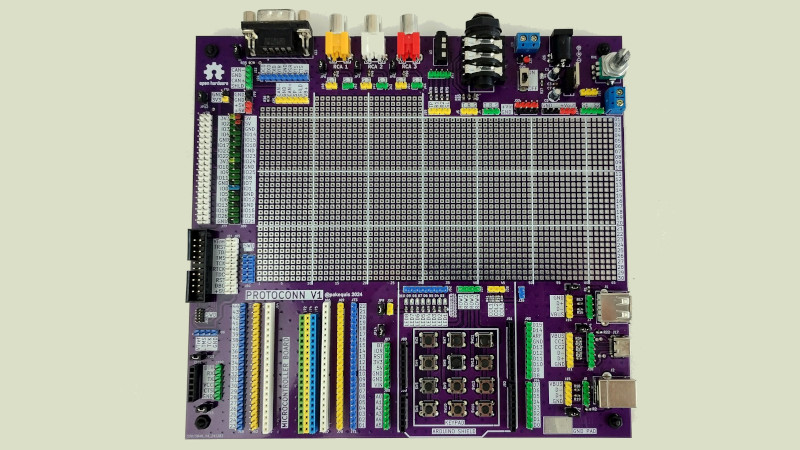Prototyping is a personal affair, with approaches ranging from dead-bug parts on tinplate through stripboard and protoboard, to solderless breadboards and more. Whichever you prefer, a common problem is that they don’t offer much in the way of solid connections to the outside world. You could use break-out boards, or you could do like [Pakequis] and make a prototyping board with every connector you can think of ready to go.
The board features the expected prototyping space in the middle, and we weren’t joking when we said every connector. There are analogue, serial, USB, headers aplenty, footprints for microcontroller boards, an Arduino shield, a Raspberry Pi header, and much more. There will doubtless be ones that readers will spot as missing, but it’s a pretty good selection.
We can imagine that with a solderless breadboard stuck in the middle it could be a very useful aid for teaching electronics, and we think it would give more than a few commercial boards a run for their money. It’s not the first we’ve featured, either.
















It misses a fuel nozzle! ( http://xkcd.com/1406/ )
I see several power supply connections.
But no diesel
Look closely the fuel nozzle has a diesel selector
It still needs a Jet A option.
Feeling sad for all those specifications being abused
Do not look away from… The Nozzle.
In days of old, we had a thing called a Printer Port.
That is called a DB25, and there are a whole bunch more in that range.
The computer end was a DB25. (And, yes, serial went from DB25 to DB9 in the 1980s, and VGA is DB15 high density.)
The really fun part with parallel cables was the Centronics connector on the other end, with its surprisingly resilient clips. (I think those are the only type of “clip” connectors that didn’t have “broken off” as their default state.)
(Er, those and external SCSI, which used the same clips.)
and some of us learned the difference between a B shell size and a E
The U.S. military is really fond of the DB-50 and 37 connectors for their hardware, or at least for a lot of their stuff that’s slowly becoming legacy systems. Lost track of all the different adaptors I had to make to go from an old 50 pin to one of the odd “keyed” barrel type connectors they use.
Real pain to solder the back of those round plugs.
no no no. you’d be much better off doing one with about 4 sets of pin headers and a bunch of adaptors for each connector type. that would allow for any connector in a much smaller footprint and also allow non breadboard friendly components/modules.
Hobbyists have been btilding cable testers based on that idea for ages, eg https://www.youtube.com/watch?v=YWJR8DLcURQ
Of course you don’t have to make all the adapters yourself, plenty of people will cheerfully sell you some.
horrendously expensive way to do. I much prefer breadboards adapters for each connector: much cheaper and if you need more than one, just hook several of the same type. This large board is a waste. Like a luxury Swiss knife that will always lack the exact function you need.
You can’t judge if it’s a waste without seeing the view #s.
Hackaday should have a special section, driving traffic for $.
yeah and the psychological factor is severe too — the moment you find one connector that you need that it doesn’t have, you’ll feel like the entire thing is 100% useless. you’ll experience disappointment, on top of the practical problem.
Where are the RF connectors?
And all the odd assorted power connectors?
I think if you would include ALL connectors the board could reach Alpha Centauri atleast twice over
This is the problem with the modern way people get into “electronics”. So stuck in Arduino land that someone who has written 3000+ tech articles would feel comfortable claiming something for prototyping that did not even have things as basic as BNC, Coax, SMA or even a Banana plug had all connectors. Dinosaur rant over.
Came here to say the exact same thing. This thing might be ok for beginner middle school kids but is missing so many essentials that it is e-waste. old man yelling at clouds rant over
Had to trouble shoot a field video system today. Was surprised to see the fairly new monitor had a BNC input connector.
Let’s see Paul Allen’s proto-board
In my day all we had was empty orange cans and raw liver and we liked it!
orange juice
Oh, you were lucky. We had to grow our own Orange Trees and eat our own livers
Forgot the all important coffee cup heating pad
Beautiful to look at, and somewhat useful, but way less practical than say small breakout boards, each one with its connector, ready to be plugged in to a breadboard or contact strip, or soldered on a perfboard.
I don’t see any fahnstock clips. Oops…too old? Oh, and those pesky Cannon Plugs. Yikes!
Very funny Hackaday, although a little premature for an April Fools.